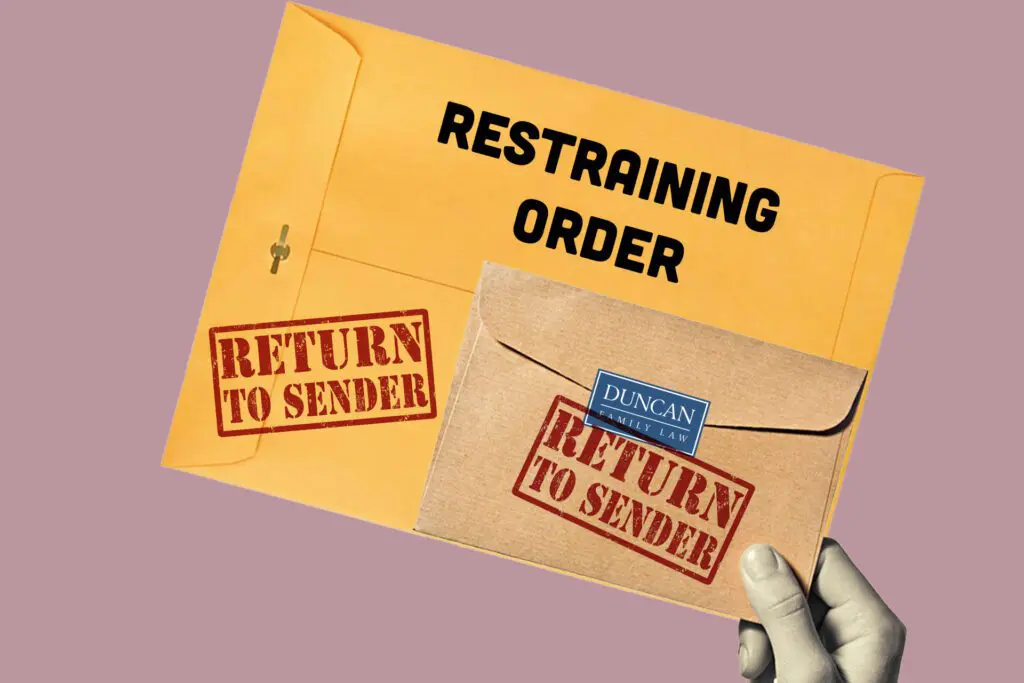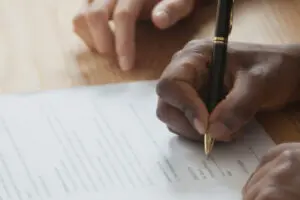Imagine the relief of obtaining a restraining order, only to find it’s like shouting into the wind if not properly served. This legal hiccup can flip your sense of security on its head, leaving you wondering where to stand.
When paperwork aimed at protecting you doesn’t reach the right hands, it’s as though your safety net has vanished. Yet, this isn’t just about missing documents; it’s about understanding the system designed to shield you from harm and how its efficacy hinges on due process.
In this guide on unserved restraining orders, we’ll go straight to the point: no (or very little) legalese —just clear insights into your rights and options when service falls short.
What Happens if a Restraining Order is Not Served?
If a restraining order is not served, it may not be legally enforceable, and the court proceedings may be affected. In some cases, alternative methods such as substituted service or service by publication can be used when the recipient’s address is unknown. However, it is essential to adhere to the specific legal procedures for alternative service to ensure that the order is served effectively. Failure to serve the restraining order properly can result in the order not being enforced, and the individual subject to the order may not be held accountable for violations. Additionally, the person seeking the restraining order may face challenges in the legal process if the order is not served correctly.
Understanding Restraining Orders

Issuance Process
When a person feels threatened, they may apply for a restraining order. Courts review these applications carefully. A judge must agree that the order is necessary to protect someone’s safety. If the judge agrees, an order is issued.
The next step is serving this order to the respondent—the person it’s against. This means officially giving them notice of the court’s decision.
Functioning and Classifications
Once served, restraining orders are legally binding. They tell one person to stay away from another or stop certain behaviors.
There are different types:
- Domestic orders often involve family or household members.
- Civil orders can be used in disputes between individuals who might not be related.
- Emergency protective orders are quick measures for immediate protection.
Each type has its own rules about how long it lasts and what actions are prohibited.
Legal Entitlements
Everyone has rights under the law. If you’re named in a restraining order, you have specific legal entitlements:
- You have a right to know if there’s an order against you.
- You can go to court to contest it.
- You may ask for changes in the terms of the order if needed.
These rights ensure fairness and allow both parties a chance to speak before the law.
Serving a Restraining Order

Alternative Serving Methods
When a restraining order needs to be served and the respondent is hard to reach, courts may allow other methods. One such method is service by publication, where the order’s details are published in a newspaper or online. This can happen when the restrained person cannot be found after thorough attempts.
Professional process servers also offer their services for difficult cases. They have experience and strategies for serving legal documents effectively. Law enforcement often steps in to help serve restraining orders, ensuring that respondents receive them promptly.
Unknown Respondent Addresses
Finding someone with an unknown address adds complexity to serving a restraining order. Investigators may use various tools and databases to uncover where the respondent lives or works. If these efforts fail, courts might approve alternate ways of delivering the summons.
Before using alternative service methods, one must show they’ve made serious efforts to find the respondent. This involves submitting an affidavit of due diligence to court—proof of extensive searching without success.
Temporary Order of Protection
In situations requiring immediate safety measures before formal service is possible, a temporary order of protection can be issued by a judge. It acts swiftly against potential harm from the restrained person but usually expires after short term or until there’s another court hearing on it.
Should difficulties in serving continue beyond this period, judges might extend these temporary protections as needed until successful service occurs.
Consequences of Unserved Restraining Orders
Court Hearing Implications
The court’s agenda faces delays when restraining orders are not served. Hearings may get pushed back. This is to ensure the respondent has a chance to be aware of the order. Judges often grant extra time for serving the order.
Extensions can add weeks or months to proceedings. During this period, petitioners might feel unprotected and frustrated. The legal system tries to balance fairness with protection.
Petitioner Challenges
Petitioners bear a heavy load in these cases. They must make sure the order reaches the respondent. Finding someone avoiding service proves tough sometimes.
They face both financial costs and emotional stress during this process. Each attempt at serving an order adds up, causing strain on resources and well-being.
Respondent Risks
Respondents aren’t off the hook if they dodge service initially. Once they receive notice, all terms apply immediately. Ignoring or violating these terms leads to arrest upon eventual service. Legal consequences grow once respondents are aware of their restrictions.
Knowing about an unserved restraining order increases liability for actions taken before being officially informed.
Legal Counsel’s Role
Handling Violations
When a restraining order is broken, the police step in. They act to protect the victim. If you report a violation, they will check it out. This helps keep you safe.
The law is clear here. You must have proof of violations for court cases. Keep records of any breach. This includes messages or witnesses’ accounts.
Penalties are serious if an order is ignored. The person may face fines or jail time. Sometimes, courts issue stricter orders to ensure safety.
Seeking Custody Rights
Restraining orders can change custody situations too. Courts might wait until an order is served before making decisions on custody rights.
Temporary custody could be influenced by these orders as well. It depends on each case and what judges think is best for the child involved.
The main thing in court decisions? Child safety comes first always. Courts look at all factors around this when deciding who gets custody during legal disputes involving restraining orders.
Representation in Court
You have a right to a lawyer during hearings about restraining orders. Lawyers know how to deal with issues like not being able to serve someone with an order. They’re skilled in presenting your side clearly and effectively too.
It’s possible to represent yourself but it’s tough due to legal complexity. A domestic violence attorney makes sure your voice gets heard properly in these situations.
Dealing with Abuser Proximity
Before Service
A restraining order holds no power until the abuser is served. The petitioner keeps a copy, while the court clerk files the original. Until service completion, the respondent doesn’t know about the order.
Service must happen for protection to start. If not served, safety risks may remain for those in an intimate relationship or others close to the abuser. It’s crucial for petitioners to understand this gap in enforcement.
Emergency Orders
Emergency orders act fast against immediate threats. They last short-term and need quick service to work effectively. These are critical when abuse poses an instant danger.
For example, if someone threatens harm, an emergency order can provide swift protection until a formal hearing occurs. But remember, it only works once served.
Contact Restrictions
Restraining orders often ban all contact from the abuser—direct and indirect alike. This includes calls, messages, and even social media interactions.
- No direct communication allowed.
- Must stay away from petitioner’s home/work.
Specific distances may be set by courts to keep victims safe from relatives or friends who pose a threat.
Penalties for Order Violations

California Specifics
In California, the law is clear. Proof of service must be filed before an order can be enforced. This rule applies to all types, including those for domestic violence and elder abuse. Each type has its own set of requirements.
The state provides help with serving orders. The sheriff’s department often handles this process. They ensure that the person named in the order receives it officially.
Domestic Violence Cases
Courts take domestic violence seriously. These cases are fast-tracked because of the risk involved. Victims may get temporary protection quickly.
Once served, individuals may have to give up their firearms immediately in many places. This rule helps protect victims from further harm.
Civil Harassment Cases
Sometimes disputes arise between people who are not family or partners—like neighbors or co-workers. In these situations, restraining orders can help resolve conflicts and prevent harassment.
Just like other cases, there needs to be proof before a judge issues an order here too. There aren’t automatic firearm bans in these cases unless the order specifically says so.
Addressing Order of Protection Violations
Respondent’s Violations
Once an order of protection is served, the respondent must adhere to its terms. The consequences are clear from the start. Ignorance is not a defense after service, even if the breach was unintentional at first. Once aware, respondents are expected to comply fully.
Breaching an order can lead to immediate arrest by law enforcement upon confirmation of the violation. Any repeat offenses could escalate legal consequences significantly. In some areas, this might mean facing felony charges.
Legal Proceedings
For any legal action tied to a restraining order, serving it correctly is crucial. Without proof of service, full proceedings cannot begin. This includes motions or other court actions in court.
Judges keep track of cases and wait for confirmation that the respondent has been served properly. This step ensures fairness and allows all parties to prepare for what comes next legally.
Confronting the Respondent
It’s usually best not to confront someone with a restraining order against them personally. Safety should always come first in these situations. Professional servers know how to handle difficult serving tasks safely and effectively.
Using legal channels helps avoid escalating tension or causing more issues during this sensitive phase.
Utilizing Domestic Violence Resources
During the Process
Ongoing documentation is crucial. Every attempt to serve a restraining order must be recorded. This shows effort and intent to courts. Multiple serving attempts are not unusual. It’s often necessary to try several times before success.
Courts get regular updates on the status of service. They need to know if there have been problems or delays in serving the order.
Support and Advocacy Groups
Local organizations provide resources for those seeking orders of protection. These groups understand how hard it can be to navigate this process alone. They offer guidance every step of the way.
Advocacy groups help simplify complex procedures involved in serving orders. Their support makes a challenging situation more manageable.
Legal aid often comes with emotional support services from these entities:
- Counseling sessions.
- Group meetings for shared experiences.
- Hotlines for immediate emotional assistance.
Safety Planning Strategies
Creating a personal safety plan is advised while waiting for an order to be served successfully. It’s best not to wait passively, hoping everything will fall into place quickly.
Coordination with local law enforcement is part of creating a solid safety strategy:
- Inform them about your situation.
- Work together on actions you should take if you feel threatened.
Having backup plans is essential due to unpredictability in timing:
- Stay with trusted friends or family when needed.
- Know locations of safe shelters.
- Keep emergency numbers at hand at all times.
Closing Thoughts
Navigating the complexities of restraining orders can feel like threading a needle in a whirlwind, especially if the order isn’t served. You’ve got the playbook now: understand the beast, serve it right, and know the fallout if you don’t. If you’re dancing on this tightrope, remember that unserved papers can leave you unprotected and the abuser in the clear. Legal eagles are your go-to for cutting through the red tape, and proximity to an abuser means it’s game time for safety strategies. Slip-ups by your abuser? There’s a penalty flag ready to be thrown.
Don’t let confusion tackle you—resources are your offensive line against domestic violence. If you’re feeling cornered, reach out, grab those resources with both hands, and push back. Your safety’s the endgame here. Ready for the next play? Share this info like it’s hot, talk to a pro, or help a buddy in the trenches. Knowledge is power—pass it on.
Frequently Asked Questions
What happens if a restraining order isn’t served?
If the restraining order isn’t served, it can’t be enforced. The person it’s against must be officially notified for it to take effect. Without service, they’re not legally bound to follow the order’s terms.
Can an abuser be penalized if they weren’t served with a restraining order?
No, penalties only apply once an abuser has been served. They need to know about the restraining order before facing consequences for violating its conditions.
What should I do if my restraining order hasn’t been served yet?
Contact your legal counsel or the court that issued the order immediately. They’ll guide you on how to ensure proper service so that protection can begin.
How does proximity to my abuser affect me if my restraining order is unserved?
Until the abuser is served, stay vigilant and consider reaching out for support from domestic violence resources. Your safety is paramount.
If someone violates a restraining order unknowingly due to improper service, what occurs?
They cannot be held accountable for violating something they aren’t aware of. Proper service ensures everyone knows their rights and obligations under the law.
Is legal assistance necessary when dealing with unserved restraining orders?
Absolutely! A lawyer will navigate any complexities and work towards getting your protective measures in place swiftly and effectively.






